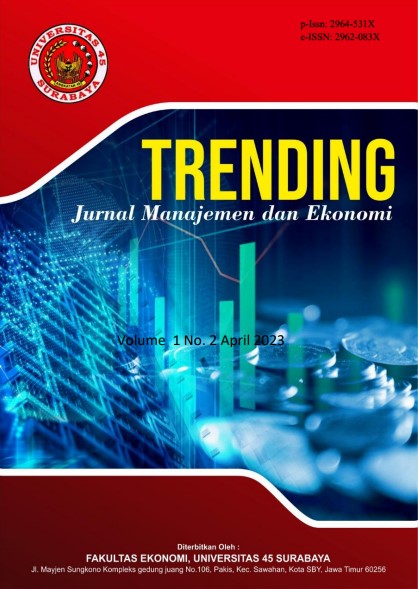The Influence of Collaborative Strategies in Promoting Increasing Sales Volume of Creative Industry MSMEs
DOI:
https://doi.org/10.30640/trending.v2i2.2377Keywords:
MSME, Creative Industry, Collaborative Strategy, Selling VolumeAbstract
This research seeks to gain a comprehensive interpretation of the collaborative strategies enforced by Micro, Small, and Medium Enterprises (MSMEs). By using a qualitative analysis approach with a descriptive framework, this research utilizes SWOT analysis as an important tool for identifying variables in formulating organizational strategy. The findings of this analysis underscore the importance for MSMEs operating in the creative industries to carefully assess their internal strengths and weaknesses, as well as external opportunities and threats, to effectively navigate increasingly fierce market competition. In particular, the intrinsic strengths of MSMEs, characterized by creativity and adaptability, play an important role in product differentiation and attracting consumer interest. Nevertheless, the challenges posed by financial constraints and limited global market access require strategic mitigation. Opportunities arising from market expansion initiatives and the strategic use of information technology provide opportunities to increase the prospects for the success of MSMEs. However, increasing awareness of competitive pressures and potential risks while maintaining product quality remains paramount. Through SWOT analysis, MSMEs can design tailored strategies to increase their competitive advantage and ensure business sustainability. Creative initiatives such as leveraging social media platforms, forging partnerships with local suppliers and artists, driving product innovation, providing exceptional customer service, and diversifying sales channels are emerging as critical enablers to increase sales volumes and achieve success amidst a highly competitive market landscape.
References
Atitumpong, A., & Badir, Y. (2017). Leader-member exchange, learning orientation, and innovative work behavior. Journal of Workplace Learning, 30, 0. https://doi.org/10.1108/JWL-01-2017- 0005
Castilho, M., & Quandt, C. (2017). Collaborative Capability in Coworking Spaces: Convenience Sharing or Community Building? Technology Innovation Management Review, 7(12), 32–42. https://doi.org/10.22215/timreview/1126
Hakim, C., Agustina, T., Yanto Rukmana, A., Hendra, J., & Ramadhani, H. (2023). The Influence of Entrepreneurship Intellectual Capital in The Contribution to Economic Growth in The City of Bandung. Jurnal Ekonomi Dan Kewirausahaan West Science, 1(02), 68–76. https://doi.org/10.58812/jekws.v1i02.237
Hidayat, W., & DW, H. (2022). Strategic Orientation, Innovation and Competitive Advantage of SMEs: A Case Study of Creative Industry in Central Java. Journal of Economics, Finance And Management Studies, 05(03). https://doi.org/10.47191/jefms/v5-i3-03
Howkins, J. (2013). The Creative Economy: How People Make Money from Ideas (2nd Edition).
Penguin UK. Jin, Y. “Henry,” Fawcett, S. E., Fawcett, A. D., & Swanson, D. (2019). Collaborative capability and organizational performance: Assessing strategic choice and purity. International Journal of Production Economics, 214, 139–150. https://doi.org/10.1016/j.ijpe.2019.04.006
Kemendag. (2009). Studi Industri Kreatif 2009. Departemen Perdagangan Republik Indonesia.
Knight, G. (2000). Entrepreneurship and Marketing Strategy: The SME under Globalization. Journal of International Marketing, 8(2), 12–32. https://doi.org/10.1509/jimk.8.2.12.19620
Kopp, C. M. (2021). “Understanding Market Orientation and How It Works.” Investopedia. Accessed on 19 February 2024, URL: https://www.investopedia.com/terms/m/market- orientation.asp#:~:text=What%20Is%20Market%20Orientation%3F,and%20services%20that% 20satisfy%20them.
Lumpkin, G. T., & Dess, G. G. (2001). Linking two dimensions of entrepreneurial orientation to firm performance. Journal of Business Venturing, 16(5), 429–451. https://doi.org/10.1016/S0883- 9026(00)00048-3
Moleong, J. L. (2017). Metode Penelitian Kualitatif. Bandung: PT. Remaja Rosdakarya.
Noor, A., Radiansyah, A., Selfiana, M., Riani, M., Ishak, P., Pi, S., Hakim, C., Rijal, S., Si, M., Harto, B., Anitha, M., Tinambunan, P., & Khamaludin, K. (2023). Human Resource Management (Manajemen Sumber Daya Manusia) (pp. 162–170).
Nurfitrah, F. S., Danial, R. D. M., & Ramdan, A. M. (2022). “Kapabilitas Relasional dan Inovasi Produk dalam Meningkatkan Keunggulan Bersaing Pada Masa Covid-19 (Studi Pada Industri Kreatif Fesyen Busana Kota Sukabumi).” MSEJ : Management Studies and Entrepreneurship Journal , 3(4).
Suryadharma, M., Asthiti, A. N. Q., Putro, A. N. S., Rukmana, A. Y., & Mesra, R. (2023). Strategi Kolaboratif dalam Mendorong Inovasi Bisnis di Industri Kreatif: Kajian Kualitatif pada Perusahaan Desain Grafis. Sanskara Manajemen Dan Bisnis, 1(03), 172–181. https://doi.org/10.58812/smb.v1i03.221
Downloads
Published
How to Cite
Issue
Section
License
Copyright (c) 2024 Trending: Jurnal Manajemen dan Ekonomi

This work is licensed under a Creative Commons Attribution-ShareAlike 4.0 International License.








